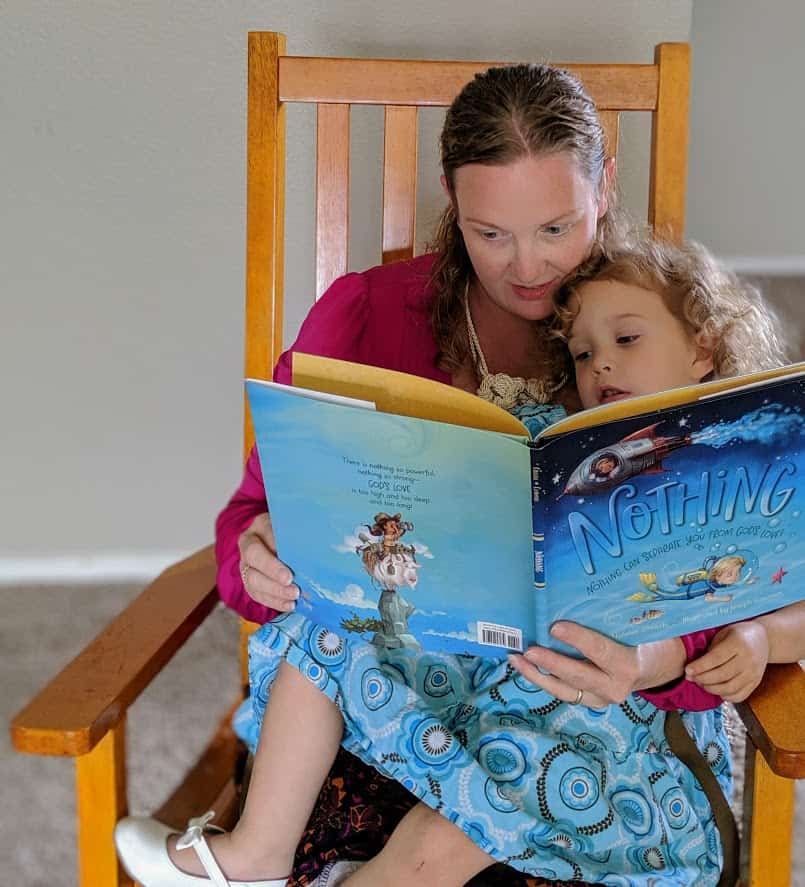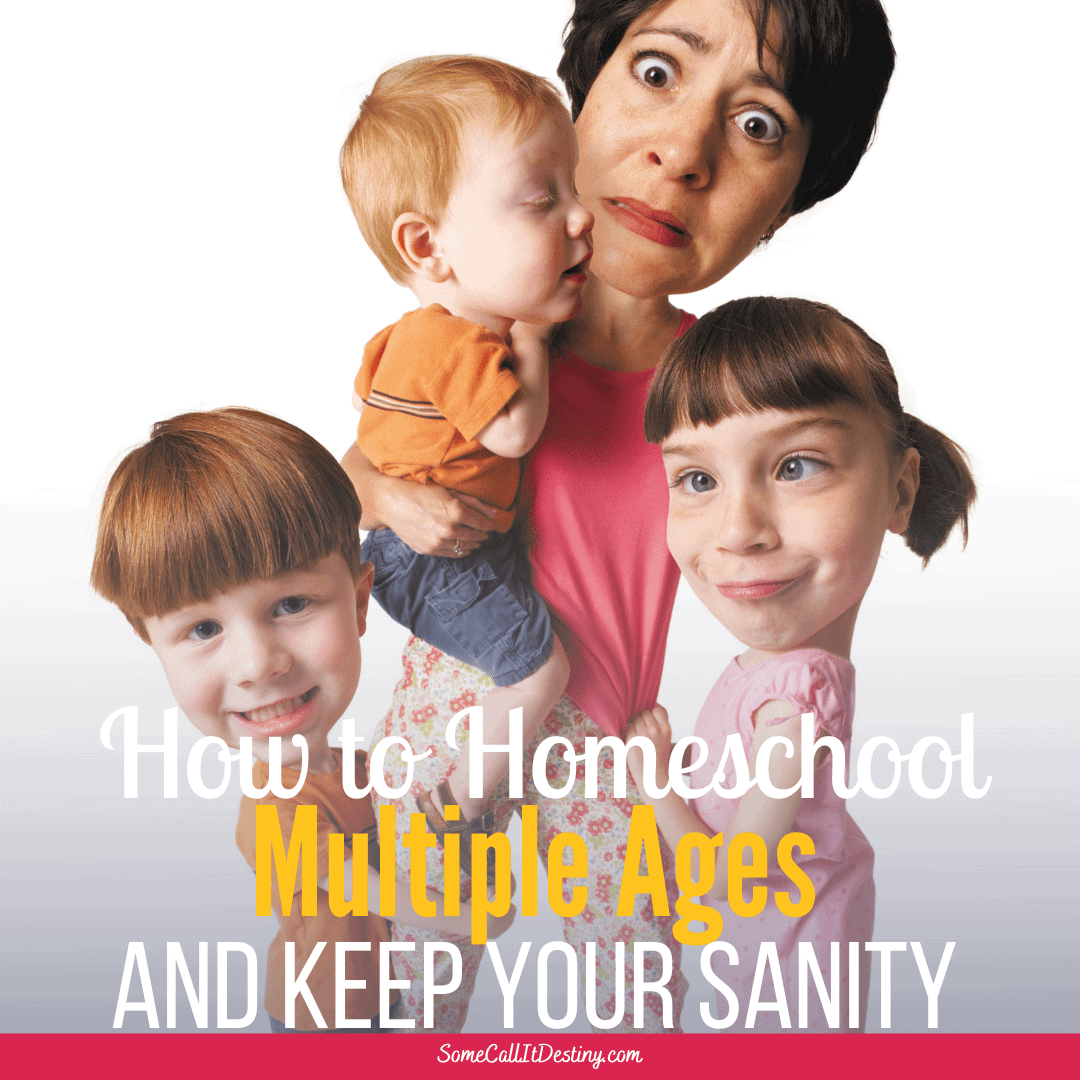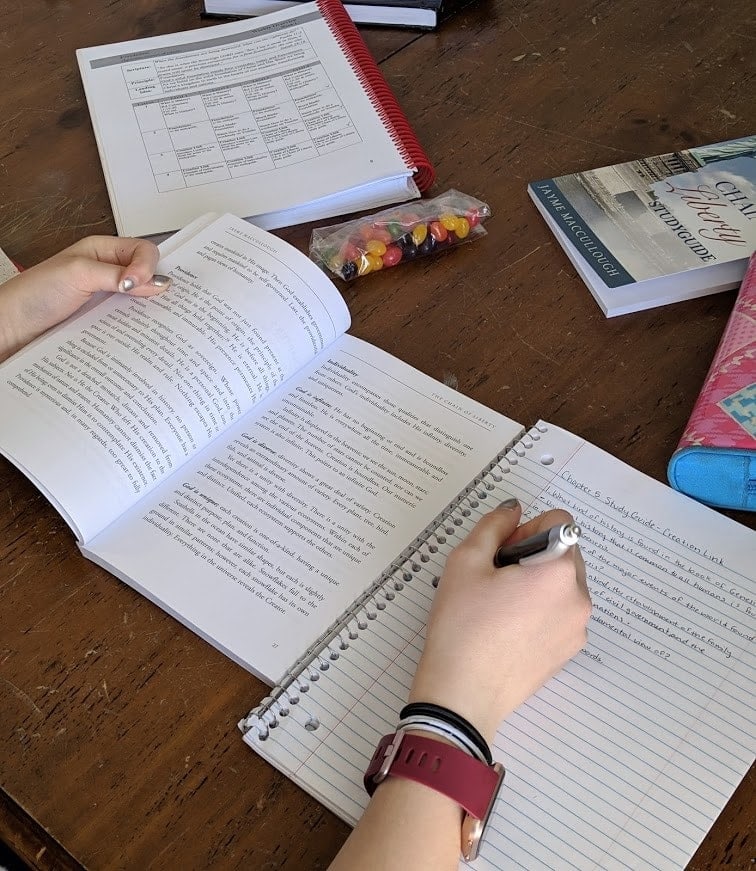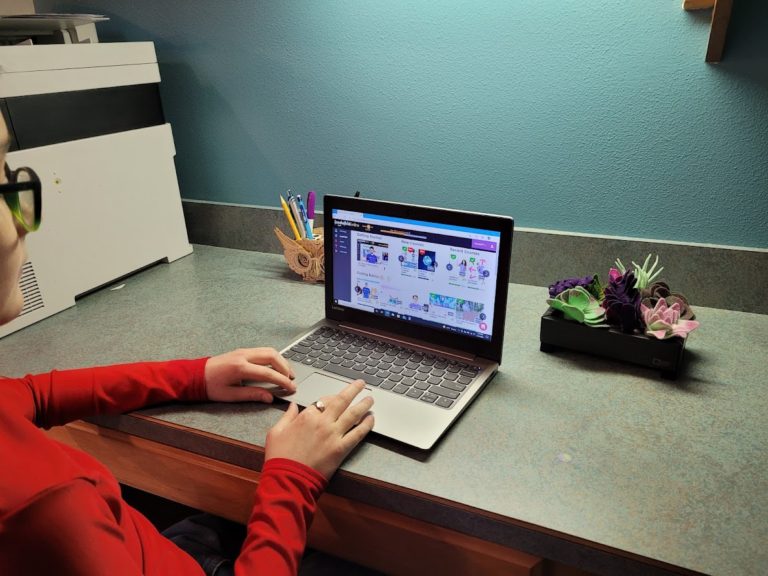How to Homeschool Multiple Ages and Keep Your Sanity
Inside: Six strategies for homeschooling multiple ages without losing your sanity.
I once got asked while out with my children if there was a breakout at the local orphanage. When people see me out with seven kids, we receive a wide range of responses. When they find out we homeschool–through high school even!–they are either in awe or think we’re crazy. Most think we’re crazy.
Why? Because they can’t fathom how in the world I manage to educate all my children, by myself. I usually get some comments about how they struggle with their (insert number here) children. If you have a large family or homeschool more than one kid, you can probably relate.

Even among other homeschool families, homeschooling multiple ages can seem daunting. In fact, it can leave you feeling overwhelmed and struggling to hang on to your sanity.
I get it. It can be hard when your attention is being pulled in fifty million directions with multiple children shouting questions at you, your preschooler demanding your undivided attention, and the toddler dumping out the crayon box while simultaneously crushing his goldfish on the floor.
It sounds like madness. And who wants to volunteer to live in the crazy house?
But homeschooling multiple ages doesn’t need to threaten your sanity.
So, how do I keep my sanity while homeschooling multiple ages? Let me share six strategies that I’ve learned work best for us.
To Keep Your Sanity Homeschooling Multiple Ages You Gotta Be Prepared

One does not wake up on a Monday with no plan and expect the day to go smoothly. As mom, you need to be prepared. Having a game plan in place increases your chances of ending the week with your sanity in tack.
I’m not saying you need to sit down and write detailed lesson plans. Although kudos if you’re that mom. I’m not. I lesson plan one quarter at a time by number, not days of the week. This ensures both the kids and I know what is expected each day. It also allows for flexibility if we take off a random Wednesday. I have also had seasons where I planned week by week. Find what works for you.

The weekend before I scout our lesson plans for upcoming projects or labs so I can gather materials and plan around it. I also write upcoming appointments and events on our family calendar so everyone can see.
Meals and snacks occur at set times, and for the most part consist of a rotation of choices.
Chores are written on the board and have to be accomplished before the end of the day and before any screen time (including phones).
These simple steps of preparation decrease the chance I’ll spend the week feeling overwhelmed or like I’m going to lose it at any moment. A little organization goes a long way in setting the tone for your week.
You can grab my free homeschool planner here to help with organization and planning.
Pick the Right Curriculum
Finding the perfect curriculum is a bit like finding the Holy Grail–a never-ending search. So when I say pick the right curriculum, I’m not suggesting there is a specific curriculum perfect for families homeschooling multiple ages.

However, you do need to take an honest inventory of your specific family. I learned early on I needed to pass on curriculum that required a lot of preparatory work on my part. With a large family, I simple don’t have the time.
I also realized I needed a self-grading math program for my older children because I couldn’t sit with all of them individually as they did their work and I didn’t want them completing the same mistakes through an entire lesson.

Choosing subjects that lend themselves towards independent learning is also fundamental in our homeschool. I rely on my children being able to read through the lessons and complete work on their own for certain subjects so I can work with siblings.
Taking into account my strengths and limitations, as well as those of my family, allows me to pick a curriculum that works for homeschooling multiple ages.
Trust me, the last thing you want is a curriculum running you ragged. If your current curriculum stresses you out, reevaluate and look into one that will be a better fit.
|Related| An Exciting Look at Our Spectacular Homeschool Curriculum Choices
When Homeschooling Multiple Ages Start with the Youngest Child
Before our homeschool day begins, I focus first on filling my toddler and preschooler’s attention banks. I read them a book, love on them a little, and make sure they’ve had some mom time. If they don’t feel like they are starving for my attention, I get interrupted less often. I can then set them up with an activity and start our homeschool day.

With the non-school aged children taken care of, I start with my youngest school-aged child. This is because she will need the most help and isn’t yet at an age where she can learn independently. While I am going over her lessons, my other children are to work independently on their schoolwork.
If they come to a question or need help, they are to move on to the next question or subject until it is their turn. This keeps them progressing and allows me to focus on the child I’m currently with.
From there I work my way up, making sure I have time with each child so I can give instruction and answer questions. The actual instruction time gets less as grades go up. My high schooler is a fully independent learner. My role as her educator is to clarify material when she has questions, grade assignments, and have discussions about the information she is learning.
Take Advantage of Family School Subjects

There are some subjects which must be done individually, math for instance. But for others, a family school approach works beautifully. Family school is where all students, regardless of age, gather to learn together. Assignments or activities are then given based on the skill level of the child.
History is a great example of a subject that lends itself nicely to a family school setting. Giving the same lesson to all students saves time and sanity.
Minimize Distractions to Keep Your Sanity While Homeschooling Multiple Ages

Distractions. They come in many forms and affect both mom and kids. They can completely uproot your homeschool day. Keeping kids on task is much easier if you yourself are not likewise distracted.
I am ashamed of the number of times I have sat down at my computer in the morning to check email only to realize I’ve rabbit trailed all over the internet, kids are now asking for lunch and little to no school work has been done.
The fault is entirely mine. And it means I am going to spend the rest of the day struggling to get kids to focus because I wasted all their best learning time being distracted.
I find our day runs smoother when I am both physically and mentally present while my children do their work.
This means I don’t check my phone and I put off getting online until after our instruction time is over.
It means putting off outside errands and not scheduling appointments in the middle of our school day.
Identify your distractions and work to overcome them.
Invest in Hidden Supplies of Chocolate and Caffeinated Beverages

I have a system in place for homeschooling multiple ages without losing my sanity and most of the time it works. But sometimes, it doesn’t. Some days the toddler misses his nap, one kid is upset because another is breathing their air, and the teenager is contrary. It happens.
Occasionally, you’re going to have a day (or week) that tries your sanity. The key is for it to be the exception and not the norm. For those times I have on hand some dark chocolate and Diet Coke. I sneak away and take five minutes for myself before heading back into the fray.
Discover what your quick refresh is to help you get through those days when homeschooling feels more like a war zone than a peace rally. Your sanity need not be sacrificed.
Remember These 6 Strategies to Homeschool Multiple Ages Without Losing Your Sanity
With a little bit of effort, it is possible to homeschool multiple ages without losing your sanity. Just remember to:
- Start your week prepared. Plan out lessons, meals, chores and appointments.
- Choose a curriculum that works for your family and your circumstances.
- Start with the youngest child while older children work independently.
- Save time by doing some subjects as a family.
- Avoid distractions so you can be both physically and mentally present.
- Identify a “quick refresh” for hard days.

I hope these strategies help streamline you keep your sanity while homeschooling multiple ages.
What has worked well for you to save your sanity while homeschooling multiple children? Share your tips in the comments below.
Follow Me on Social Media
Facebook| Instagram| Pinterest| Twitter










I have kids from 18 down to 8, and I feel like you were in my head writing this! All the same, except I prefer hot tea with my dark chocolate 😉
Thanks! We are heading into this school year with a 3rd grader, Kindergartener and an infant, so this is very helpful. I’ve been trying to figure out how much I can teach them both at the same time and what needs to be totally separate. Starting with the youngest each day totally makes sense, I’ll have to give it a try.